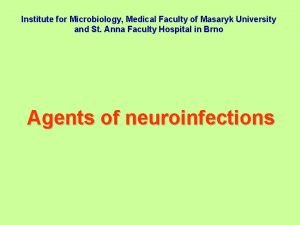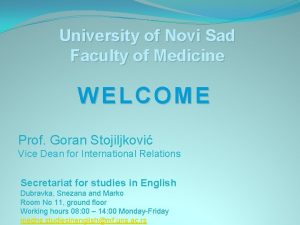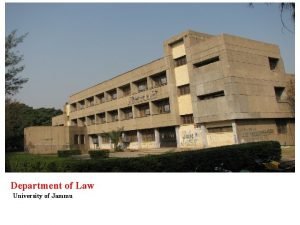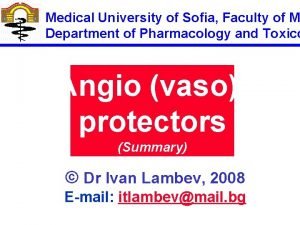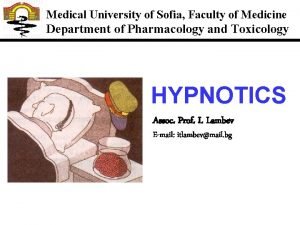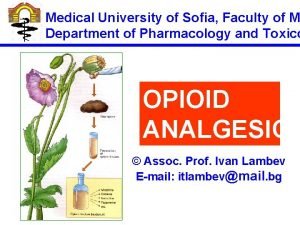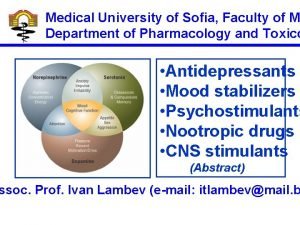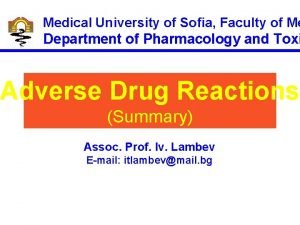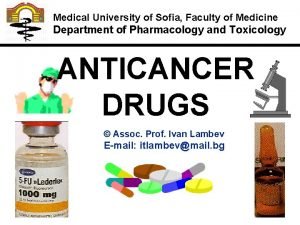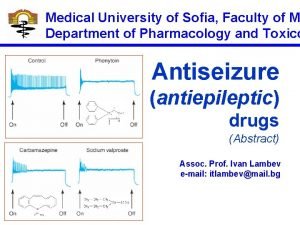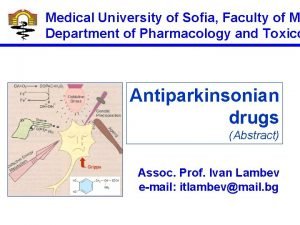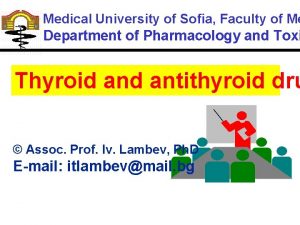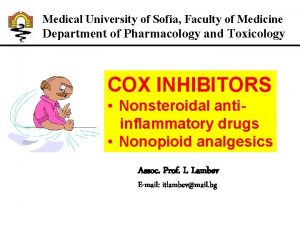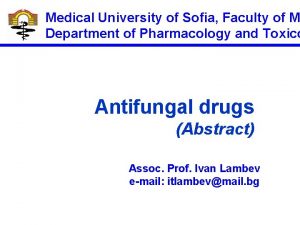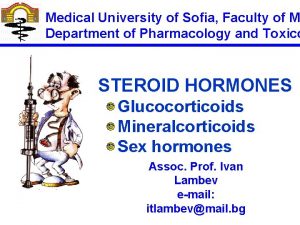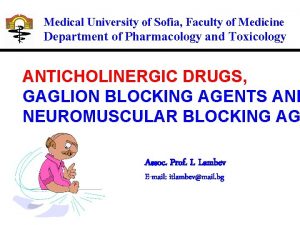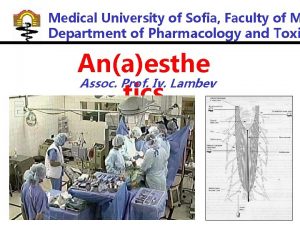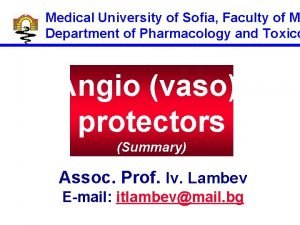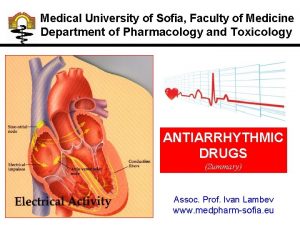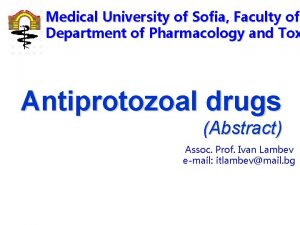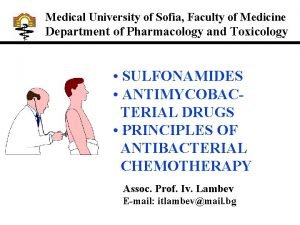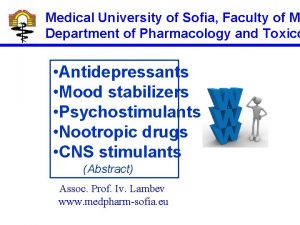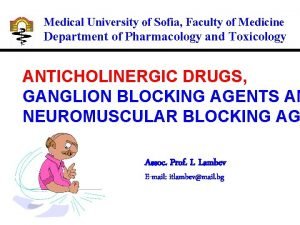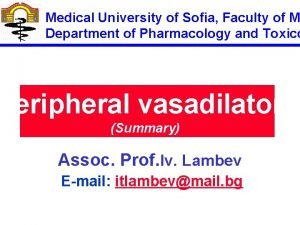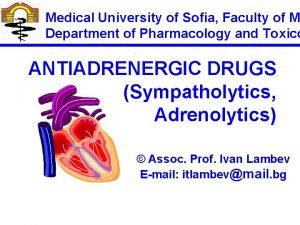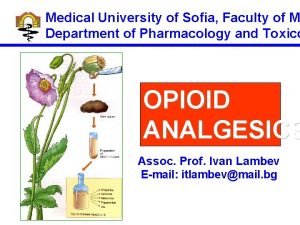Medical University of Sofia Faculty of M Department






















































- Slides: 54

Medical University of Sofia, Faculty of M Department of Pharmacology and Toxico NONBETALACTAM ANTIBIOTIC Assoc. Prof. Ivan Lambev S e-mail: itlambev@mail. bg

ANTIBIOTICS – mechanism of action Aminoglycosidesβ-lactams Polymyxins Tetracyclines Glycopeptides Chloramphenicol Macrolides Lincosamides Rifampicin

I. AMINOGLYCOSIDES Aminoglycosides have a hexose ring, either streptidine (in streptomycin) or 2 -deoxystreptamine (other aminoglycosides), to which various amino sugars are attached by glycosidic linkages. They are water-soluble, stable in solution, and more active at alkaline than at acid p. H.

Streptomycin

Streptomycin is an aminoglycoside antibiotic. Its antibacterial activity is due to it binding to the 30 S subunit of the bacterial ribosome and inhibiting of protein synthesis. It has a wide spectrum of antibacterial activity but is primarily use to treat mycobacterial infections (i. m. ). • The main problems are eighth nerve toxicity (vestibulotoxicity more than deafness), nephrotoxicity, allergic reactions.

Gentamicin Tobramycin

Mechanisms of action Aminoglycosides are irreversible inhibitors of protein synthesis, but the precise mechanism for bactericidal activity is not known. The initial event is passive diffusion via porin channels across the cell wall. Drug is then actively transported across the cell membrane into the cytoplasm. The transmembrane electrochemical gradient supplies the energy for this process. Low extracellular p. H and anaerobic conditions inhibit transport by reducing the gradient. Transport may be enhanced by cell wall-active drugs such as penicillin or vancomycin; this enhancement may be the basis of the synergism of these antibiotics with aminoglycosides.

Inside the cell, aminoglycosides bind to specific 30 S-subunit ribosomal proteins. Protein synthesis is inhibited by aminoglycosides in at least three ways: (1) interference with the initiation complex of peptide formation; (2) misreading of m. RNA, which causes incorporation of incorrect amino acids into the peptide, resulting in a nonfunctional or toxic protein; (3) breakup of polysomes into nonfunctional monosomes. These activities occur more or less simultaneously, and the overall effect is irreversible and lethal for the cell.


Aminoglycosides act bactericidal on dividing and no dividing microorganisms. They are in general active against staphylococci and aerobic Gram-negative organisms including P. aeruginosa and almost all the Enterobacteriaceae.

Clinical uses Aminoglycosides are mostly used against Gramnegative enteric bacteria, especially when the isolate may be drug-resistant and when there is suspicion of sepsis. They are almost always used in combination with a β-lactam antibiotic to extend coverage to include potential Grampositive pathogens and to take advantage of the synergism between these two classes of drugs. Penicillin-aminoglycoside combinations also are used to achieve bactericidal activity in treatment of enterococcal endocarditis and to shorten duration of therapy for viridans streptococcal and staphylococcal endocarditis.

Amikacin Gentamicin – sol. 80 mg/2 ml (80 mg/8 h i. m. ) Kanamycin Neomycin - Bivacin – spray derm. fl 150 ml (neomycin/bacitracin) - Nemybacin – ung. ophth. 2, 5 g (neomycin/bacitracin) Streptomycin Tobramycin

Spectinomycin is structurally related to aminoglycosides. It lacks amino sugars and glycosides bonds. Spectinomycin is active against many Gram-positive and Gram-negative organisms, but it is used as an alternative treatment for drug-resistant gonorrhea or gonorrhea in penicillin-allergic patients. Strains of gonococci may be resistant to spectinomycin, but there is no cross-resistance with other drugs. Spectinomycin is rapidly absorbed after i. m. injection. A single dose of 40 mg/kg up to a maximum of 2 g is given. There is pain at the injection site. Nephrotoxicity and anemia have been observed rarely.

Adverse effects All aminoglycosides are ototoxic and nephrotoxic. Ototoxicity and nephrotoxicity are more likely to be encountered when therapy is continued for more than 5 days, at higher doses, in the elderly, and in the setting of renal insufficiency. Concurrent use with loop diuretics (eg, furosemide, ethacrynic acid) or other nephrotoxic antimicrobial agents (vancomycin, amphotericin) can potentiate nephrotoxicity and should be avoided. Ototoxicity can manifest as auditory damage, resulting in tinnitus and high-frequency hearing loss initially, or as vestibular damage, evident by vertigo, ataxia, and loss of balance.

Streptomycin and gentamicin are the most vestibulotoxic. Nephrotoxicity results in rising serum creatinine levels or reduced creatinine clearance. Neomycin, kanamycin, and amikacin are the most ototoxic agents. Neomycin, tobramycin, and gentamicin are the most nephrotoxic. In very high doses, aminoglycosides can produce a curare-like effect with neuromuscular blockade that results in respiratory paralysis. This paralysis is usually reversible by calcium gluconate (given promptly) or neostigmine. Hypersensitivity occurs infrequently.


Mechanisms of resistance 1. Production of a transferase enzyme or enzymes inactivates the aminoglycoside by adenylylation, acetylation, or phosphorylation. This is the principal type of resistance encountered clinically. 2. Impaired entry of aminoglycoside into the cell. This may be genotypic, resulting from mutation or phenotypic, resulting from growth conditions. 3. The receptor protein on the 30 S ribosomal subunit may be deleted or altered as a result of a mutation.

II. TETRACYCLINES

Tetracyclines enter microorganisms in part by passive diffusion and in part by an energy-dependent process of active transport. Susceptible cells concentrate the drug intracellularly. Once inside the cell, tetracyclines bind reversibly to the 30 S subunit of the bacterial ribosome, blocking the binding of aminoacyl-t. RNA to the acceptor site on the m. RNA-ribosome complex This prevents addition of amino acids to the growing peptide. Tetracyclines are broad-spectrum bacteriostatic antibiotics that inhibit protein synthesis.


Antimicrobial Activity Tetracyclines are active against many Gram-positive and Gram-negative bacteria, including anaerobes, rickettsiae, chlamydiae, mycoplasmas, and L-forms; and against some protozoa, eg, amebas. The antibacterial activities of most tetracyclines are similar except that tetracycline-resistant strains may be susceptible to doxycycline and minocycline, all of which are poor substrates for the efflux pump that mediates resistance. Differences in clinical efficacy for susceptible organisms are minor and attributable largely to features of absorption, distribution, and excretion of individual drugs.

Pharmacokinetics Tetracyclines mainly differ in their absorption after oral administration and their elimination. Absorption after oral administration is approximately 60– 70% for tetracycline, oxytetracycline, and methacycline; and 95– 100% for doxycycline and minocycline. A portion of an orally administered dose of tetracycline remains in the gut lumen, modifies intestinal flora, and is excreted in the feces. Absorption occurs mainly in the upper small intestine and is impaired by food (except doxycycline and minocycline); by divalent cations (Ca 2+, Mg 2+, Fe 2+) or Al 3+; by dairy products and antacids, which contain multivalent cations; and by alkaline p. H.

Tetracyclines are 40– 80% bound by serum proteins. Tetracyclines are distributed widely to tissues and body fluids except for CSF, where concentrations are 10– 25% of those in serum. Minocycline reaches very high concentrations in tears and saliva, which makes it useful for eradication of the meningococcal carrier state. Tetracyclines cross the placenta to reach the fetus and are also excreted in milk. As a result of chelation with calcium, tetracyclines are bound to and damage – growing bones and teeth. Carbamazepine, phenytoin, barbiturates, and chronic alcohol ingestion may shorten the half-life of doxycycline 50% by induction of hepatic enzymes that metabolize the drug.

Tetracyclines are excreted mainly in bile and urine. Concentrations in bile exceed those in serum tenfold. Some of the drug excreted in bile is reabsorbed from the intestine (enterohepatic circulation) and may contribute to maintenance of serum levels. From 10 to 50% of various tetracyclines is excreted into the urine, mainly by glomerular filtration. Ten to 40% of the drug is excreted in feces. Doxycycline, in contrast to other tetracyclines, is eliminated by nonrenal mechanisms, do not accumulate significantly and require no dosage adjustment in renal failure.

Tetracyclines are classified as: (1) short-acting (chlortetracycline, oxytetracycline) based on plasma t 1/2 of 6– 8 h; (2) intermediate acting (demeclocycline and methacycline) – t 1/2 12 h; (3) long-acting (doxycycline and minocycline) with plasma t 1/2 16– 18 h. The almost complete absorption and slow excretion of doxycycline and minocycline allow for once-daily dosing.

Clinical Uses A tetracycline is the drug of choice in infections with M. pneumoniae, chlamydiae, rickettsiae, and some spirochetes. They are used in combination regimens to treat gastric and duodenal ulcer disease caused by H. pylori. They may be used in various Gram-positive and Gram-negative bacterial infections, including Vibrio infections. In cholera, tetracycline resistance has appeared during epidemics.

Tetracyclines remain effective in most chlamydial infections, including sexually transmitted diseases. Tetracyclines are no longer recommended in gonococcal disease because of resistance. A tetracycline usually in combination with an aminoglycoside is indicated for plague, tularemia, and brucellosis. Tetracyclines are sometimes used in the treatment of protozoal infections, eg, those due to E. histolytica or P. falciparum. Other uses include treatment of acne, exacerbations of bronchitis, community-acquired pneumonia, Lyme disease, relapsing fever, leptospirosis, and some nontuberculous mycobacterial infections (eg, M. marinum).

A newly approved tetracycline analog, tigecycline, is a semisynthetic derivative of minocycline. It is poorly absorbed orally and must be administered intravenously (t 1/2 36 h).

Many tetracycline-resistant strains are susceptible to tigecycline. Its spectrum is very broad. Coagulase-negative staphylococci and S. aureus, including MRS, vancomycin-intermediate, and vancomycin-resistant strains; streptococci, penicillin-susceptible and – resistant; enterococci, including vancomycin-resistant strains; Gram-positive rods; Enterobacteriaceae; multidrug-resistant strains of Acinetobacter spp. ; anaerobes, both Gram-positive and Gram-negative; atypical agents, rickettsiae, chlamydia, and legionella; and rapidly growing mycobacteria all are susceptible. Proteus and P. aeruginosa, however, are resistant.

Adverse Reactions Hypersensitivity reactions (drug fever, skin rashes) to tetracyclines are uncommon. Nausea, vomiting, and diarrhea are the most common reasons for discontinuing tetracycline medication. These effects are attributable to direct local irritation of the intestinal tract. Nausea, anorexia, and diarrhea can usually be controlled by administering the drug with food or carboxymethylcellulose, reducing drug dosage, or discontinuing the drug.

Tetracyclines modify the normal flora, with suppression of susceptible coliform organisms and overgrowth of pseudomonas, proteus, staphylococci, resistant coliforms, clostridia, and candida. This can result in intestinal functional disturbances, anal pruritus, vaginal or oral candidiasis, or enterocolitis with shock and death. Tetracyclines are readily bound to calcium deposited in newly formed bone or teeth in young children. When a tetracycline is given during pregnancy, it can be deposited in the fetal teeth, leading to fluorescence, discoloration, and enamel dysplasia; it can be deposited in bone, where it may cause deformity or growth inhibition. If the drug is given for long periods to children under 8 years of age, similar changes can result.

Tetracyclines can probably impair hepatic function, especially during pregnancy, in patients with preexisting hepatic insufficiency and when high doses are given intravenously. Hepatic necrosis has been reported with daily doses of ≥ 4 g i. v. Renal tubular acidosis and other renal injury resulting in nitrogen retention is a conraindication to the administration of outdated tetracycline preparations. Tetracyclines given with diuretics may produce nitrogen retention. Tetracyclines other than doxycycline may accumulate to toxic levels in patients with impaired kidney function.

Intravenous injection can lead to venous thrombosis. Intramuscular injection produces painful local irritation and should be avoided. Systemically administered tetracycline, especially demeclocycline, can induce sensitivity to sunlight or ultraviolet light, particularly in fair-skinned persons. Dizziness, vertigo, nausea, and vomiting have been noted particularly with doxycycline and Minocycline at high doses.


The main mechanisms of resistance to tetracycline and its analogues are: (1) impaired influx or increased efflux by an active transport protein pump; (2) ribosome protection due to production of proteins that interfere with tetracycline binding to the ribosome; 3) enzymatic inactivation.

III. CHLORAMPHENICOL Chloramphenicol and macrolides bind to the 50 S subunit and block transpeptidation and protein synthesis. It has bacteriostatic action.


Because of potential toxicity, bacterial resistance, and the availability of many other effective alternatives, chloramphenicol is rarely used. It may be considered for treatment of serious rickettsial infections such as typhus and Rocky Mountain spotted fever. It is an alternative to a beta-lactams for treatment of meningococcal meningitis occurring in patients who have major hypersensitivity reactions to penicillin or bacterial meningitis caused by penicillin-resistant strains of pneumococci.

Adverse Reactions of Chloramphenicol Adults occasionally develop nausea, vomiting, and diarrhea. This is rare in children. Oral or vaginal candidiasis may occur as a result of alteration of normal microbial flora. Chloramphenicol causes a dose-related reversible suppression of red cell production at dosages exceeding 50 mg/kg/d after 1– 2 weeks. Aplastic anaemia, a rare consequence (1 in 24 000 to 40 000 courses of therapy) of chloramphenicol administration by any route. It tends to be irreversible and can be fatal.

Newborn infants lack an effective glucuronic acid conjugation mechanism for the degradation and detoxification of chloramphenicol. Consequently, when infants are given dosages above 50 mg/kg/d, the drug may accumulate, resulting in the gray baby syndrome, with vomiting, flaccidity, hypothermia, gray color, shock, and collapse. To avoid this toxic effect, chloramphenicol should be used with caution in infants and the dosage limited to 50 mg/kg/d or less (during the first week of life) in full-term infants. Chloramphenicol inhibits hepatic microsomal enzymes that metabolize phenytoin and warfarin.


IV. MACROLIDES and KETOLIDES Azithromycin (t 1/2 40– 68 h, tab. 500 mg) Erythromycin Clarithromycin (antihelicobacter activity) Josamycin (saliva excretion) Midecamycin Oleandomycin (saliva excretion) Roxithromycin Spiramycin (saliva excretion) Rodogyl® (spiramicin/metronidazole) with significant saliva excretion) Ketolides: Telithromycin

Inhibition of bacterial protein synthesis by macrolides

Erythromycin is effective against Gram-positive microorganisms (pneumococci, streptococci, staphylococci, and corynebacteria), Mycoplasma, legionella, Chlamydia trachomatis, listeria, and certain mycobacteria, Gram-negative organisms such as Neisseria spp. , Bordetella pertussis, Bartonella henselae, and B. quintana (etiologic agents of cat-scratch disease and bacillary angiomatosis), some rickettsia spp. , T. pallidum, and campylobacter spp. are susceptible.

Adverse Reactions of Erythromycin Anorexia, nausea, vomiting, and diarrhea accompany oral administration. GI intolerance, which is due to a direct stimulation of gut motility, is the most common reason for discontinuing erythromycin and substituting another antibiotic. Erythromycin can produce acute cholestatic hepatitis (fever, jaundice, impaired liver function), probably as a hypersensitivity reaction. Most patients recover from this, but hepatitis recurs if the drug is readministered. Erythromycin metabolites can inhibit cytochrome P 450 enzymes and thus increase the serum concentrations of theophylline, oral anticoagulants, cyclosporine, methylprednisolone, and digoxin.

Resistance to erythromycin is usually plasmidencoded. Three mechanisms have been identified: (1) reduced permeability of the cell membrane or active efflux; (2) production (by Enterobacteriaceae) of esterases that hydrolyze macrolides; (3) modification of the ribosomal binding site (so-called ribosomal protection) by chromosomal mutation or by a macrolide-inducible or constitutive methylase. Cross-resistance is complete between erythromycin and the other macrolides.

Clarithromycin is derived from erythromycin by addition of a methyl group and has improved acid stability and oral absorption compared with erythromycin. Clarithromycin and erythromycin are virtually identical with respect to antibacterial activity except that clarithromycin is more active against M. avium complex. Clarithromycin also has activity against M. leprae, T. gondii, and H. pylori. Erythromycin-resistant streptococci and staphylococci are also resistant to clarithromycin. The advantages of clarithromycin compared with erythromycin are lower incidence of gastrointestinal intolerance and less frequent dosing.

Azithromycin has spectrum of activity and clinical uses virtually identical to those of clarithromycin. Azithromycin is active against M. avium complex and T. gondii. Azithromycin is slightly less active than erythromycin and clarithromycin against staphylococci and streptococci and slightly more active against H. influenzae. Azithromycin is highly active against chlamydia. It plasma t 1/2 is long.

Many macrolide-resistant strains are susceptible to ketolides. Telithromycin is active in vitro against S. pyogenes, S. pneumoniae, S. aureus, H. influenzae, Moraxella catarrhalis, mycoplasmas, Legionella, Chlamydia, H. pylori, N. gonorrhoeae, B. fragilis, and T. gondii.

V. LINCOSAMIDES Clindamycin is a chlorine-substituted derivative of lincomycin, an antibiotic that is elaborated by Streptomyces lincolnensis.

Clindamycin is indicated for treatment of anaerobic infection caused by bacteroides and other anaerobes that often participate in mixed infections. Clindamycin, sometimes in combination with an aminoglycoside or cephalosporin, is used to treat penetrating wounds of the abdomen and the gut; infections originating in the female genital tract, eg, septic abortion and pelvic abscesses; and aspiration pneumonia. Clindamycin is now recommended rather than erythromycin for prophylaxis of endocarditis in patients with valvular heart disease who are undergoing certain dental procedures. Common adverse effects are diarrhea and colitis due to C. difficile; nausea, skin rashes; impaired liver function and neutropenia.

VI. STREPTOGRAMINS Quinupristin-dalfopristin is a combination of two streptogramins – quinupristin, a streptogramin B, and dalfopristin, a streptogramin A in a 30: 70 ratio. It is rapidly Bactericidal for most microorganisms. Synercid® (Quinupristin-dalfopristin) is approved for treatment of infections caused by staphylococci or by vancomycinresistant strains of E. faecium, but not E. faecalis, which is resistant. The principal toxicities are infusion-related events, such as pain at the infusion site, and an arthralgia-myalgia syndrome.

VII. GLYCOPEPTIDES Teicoplanin, Bacitracin and Vancomycin interfere with the transport of peptdoglycans through the cytoplasmic membrane and are active against Gram-positive bacteria. Bacitracin is polypeptide mixture, markedly nephrotoxic and used only topically with neomycin. Vancomycin and Teicoplanin are glycopeptide and the drug of choice for the oral treatment of bowel inflammations occurring as a complication of antibiotic therapy (pseudomembranous enterocolitis caused by Clostridium difficile). It is not absorbed.

VIII. OXAZOLIDINONES Linezolid is a member of the oxazolidinones, a new class of synthetic antimicrobials. It is active against Gram-positive organisms including staphylococci, streptococci, enterococci, Gram-positive anaerobic cocci, and Gram-positive rods such as corynebacteria and L. monocytogenes. It is primarily a bacteriostatic agent except for streptococci, for which it is bactericidal. Linezolid inhibits protein synthesis by preventing formation of the ribosome complex that initiates protein synthesis. Its unique binding site, located on 23 S ribosomal RNA of the 50 S subunit, results in no cross-resistance with other drug classes.
 Masaryk university medical faculty
Masaryk university medical faculty Masaryk university medical faculty
Masaryk university medical faculty Nit calicut chemistry faculty
Nit calicut chemistry faculty E-learning sofia university
E-learning sofia university University of chemical technology and metallurgy
University of chemical technology and metallurgy Technical university sofia
Technical university sofia Technical university of sofia
Technical university of sofia Medical faculty in novi sad dean
Medical faculty in novi sad dean Herszon kherson maritime college of merchant marine fleet
Herszon kherson maritime college of merchant marine fleet University of bridgeport engineering
University of bridgeport engineering University of bridgeport computer engineering
University of bridgeport computer engineering Hubert kairuki memorial university faculty of medicine
Hubert kairuki memorial university faculty of medicine Hyperparathyreosis
Hyperparathyreosis Applied medical sciences
Applied medical sciences Florida state university computer science
Florida state university computer science Mendel university faculty of business and economics
Mendel university faculty of business and economics Singularity university faculty
Singularity university faculty Semmelweis university faculty of medicine
Semmelweis university faculty of medicine Faculty of engineering university of porto
Faculty of engineering university of porto Webkredit cuni
Webkredit cuni Faculty of veterinary medicine cairo university logo
Faculty of veterinary medicine cairo university logo Faculty of law of the university of zagreb
Faculty of law of the university of zagreb University of montenegro faculty of law
University of montenegro faculty of law University of kragujevac faculty of technical sciences
University of kragujevac faculty of technical sciences University of cologne faculty of management
University of cologne faculty of management Leading university teacher
Leading university teacher Hacettepe university faculty of medicine
Hacettepe university faculty of medicine Brown university computer science
Brown university computer science دانشگاه دامپزشکی تهران
دانشگاه دامپزشکی تهران Semmelweis university faculty of medicine
Semmelweis university faculty of medicine Faculty of engineering lebanese university
Faculty of engineering lebanese university York u myfile
York u myfile Elearningunideb
Elearningunideb Clemson university electrical engineering
Clemson university electrical engineering Faculty of veterinary medicine cairo university
Faculty of veterinary medicine cairo university Faculty of mechanical engineering thammasat university
Faculty of mechanical engineering thammasat university Mendel university faculty of business and economics
Mendel university faculty of business and economics Mahidol university public health
Mahidol university public health Facultad de ciencias de la salud uma
Facultad de ciencias de la salud uma Faculty of education khon kaen university
Faculty of education khon kaen university Chulalongkorn university uniform
Chulalongkorn university uniform Cairo university faculty of veterinary medicine
Cairo university faculty of veterinary medicine Importance of medical records
Importance of medical records Medical education and drugs department
Medical education and drugs department Department of law university of jammu
Department of law university of jammu Department of geology university of dhaka
Department of geology university of dhaka University of padova psychology
University of padova psychology University of bridgeport it department
University of bridgeport it department University of iowa math department
University of iowa math department Department of physics university of tokyo
Department of physics university of tokyo Texas state psychology program
Texas state psychology program Department of information engineering university of padova
Department of information engineering university of padova Department of information engineering university of padova
Department of information engineering university of padova Manipal university chemistry department
Manipal university chemistry department Syracuse university pool
Syracuse university pool

